-
Medical journals
- Career
A cost minimization analysis of α2b-interferon supplementation in complex pharmacotherapy of rotavirus infection in newborns
Authors: Serhii O. Soloviov 2; Serhii H. Ubohov 3; Tetiana A. Aleksandrina 1; Olena V. Kovaliuk 1; Iryna V. Dziublyk 1; Viktor V. Trokhymchuk 4; Hlib V. Zahoriy 4
Authors‘ workplace: Virology Department, Shupyk National Medical Academy of Postgraduate Education, Kyiv, Ukraine 1; Virology Department, Shupyk National Medical Academy of Postgraduate Education , Dorogozhitska str. 9, 04112 Kyiv, Ukraine 2; Quality Control and Standardization of Medicines Department, Shupyk National Medical Academy of Postgraduate Education, Kyiv, Ukraine 3; Organizations and Economics of Pharmacy Department, Shupyk National Medical Academy of Postgraduate Education, Kyiv, Ukraine 4
Published in: Čes. slov. Farm., 2020; 69, 83-89
Category: Original article
Overview
Rotavirus is one of the most important causative agents of gastroenteritis in both infants and children worldwide, resulting in high mortality and morbidity, mainly in low-income, developing countries. Respective analysis of medical records of newborns hospitalized with acute gastroenteritis showed that the use of α2b-interferon in complex pharmacotherapy was characterized by faster reverse development of clinical manifestations of the disease than in patients who did not receive interferon. In our study, we also aimed to estimate the effectiveness of α2b-interferon supplementation in combination pharmacotherapy of newborns with suspected rotavirus infection. Achievement of this goal was possible with the construction of a decision tree model and determination of decision rules for inclusion of α2b-interferon supplementation into the complex pharmacotherapy. The input parameters of the model were hospitalization days of patients stratified by such signs as the presence or absence of rotavirus infection, as well as the additional inclusion of α2b-interferon supplementation in complex pharmacotherapy. The criterion for prediction and decision-making was global retrospective rotavirus prevalence. The feature of the simulation was that the costs were expressed as relative to each other, which allowed unifying the proposed methodology. Retrospective analysis of the clinical database of Ukrainian newborns with acute diarrhea has proved that the decision of α2b-interferon supplementation as additional treatment could be cost-saving under 7.4 times its lower price.
Keywords:
newborn – Rotavirus infection – interferon – cost minimization analysis
Introduction
Viruses play one of the leading roles in human pathology, causing a large number of acute and chronic diseases. In the twentieth century, viral infections have caused far more deaths than all armed conflicts that took place during this period. For example, during the 1980s, about 300 million people died from natural smallpox, and the influenza virus caused about 100 million deaths mostly during the Spanish influenza pandemic of 1918–1919 and later pandemics1–7). Although the number of deaths caused by viral infections has decreased, they continue to be a significant factor in reducing overall labor productivity. For example, in the United States, there are about 200,000 hospitalizations annually caused by influenza and about 30 million cases of acute gastroenteritis, resulting in 120,000 hospitalizations annually8).
The problem of the global spread of acute gastroenteritis is currently relevant9–11) as it is high on the list of human infectious diseases, ranking right after influenza and acute respiratory infections12). The spectrum of pathogens causing acute gastroenteritis is diverse and includes pathogenic and opportunistic bacteria, protozoa, and also viruses13–16). Several studies have shown that viruses cause from 25 to 60% acute gastroenteritis cases, and among them, rotaviruses play a leading role17, 18). More than 110 million cases of rotavirus infection (RVI) worldwide, mostly among young children, are reported annually, about 25 million of these are being admitted to hospital19). In Ukraine, RVI incidence varied from 0.93 to 3.18 per 100,000 in the total population in different years, tending to increase, especially among young children20, 21). Further analysis of retrospective monthly RVI incidence epidemiological data in Ukraine (Form 3 of Statistical Report) from 2010 to 2016, provided by the Center for Public Health of the Ministry of Health of Ukraine, showed monthly morbidity 2–5 cases per 100 thousand population (500–2000 cases per month) mainly among children aged under 5 years with pronounced seasonality in the autumn-winter period and upward dynamic trend. Information on asymptomatic RVI cases was unknown, so it was assumed that RVI has been considered to be severe with symptoms according to the Vesikari grading scale ≥ 1122).
The diverse spectrum of viral actions on the human body, the spread of viral infections and severe complications determine the relevance of effective pharmacotherapy. Currently, several antiviral drugs are known and introduced into medical practice; they belong to different groups of substances, such as nucleosides analogs, interferons, immunoglobulins G, etc.23). The ongoing relevance of viral diseases stimulates the development of new therapies, and their implementation into medical practice will be accompanied by an emerging issue of their effectiveness. Methods of complex pharmacotherapy of rotavirus gastroenteritis in children that include symptomatic, pathogenetic and diet pharmacotherapy are aimed primarily at rehydration, detoxification of the body and normalization of intestinal microbiocenosis. Given the lack of etiotropic pharmacotherapy for RVI, there is an urgent need to develop therapies aimed at suppressing certain stages of rotavirus reproduction. From a theoretical point of view, the most promising for this purpose are interferons or their inducers, which have probable antiviral effect: block the synthesis of viral proteins or inhibit other stages of reproduction of a wide range of viruses. Interferons, widely used for 20 years in the protocols for the treatment of acute intestinal infections in post-Soviet countries, are divided into types by IFN-α, IFN-β, IFN-γ, and by manufacturing method – natural (first generation drugs) and recombinant (second generation drugs). The use of interferons for the treatment of viral infections strongly suggest a possible positive effect of recombinant interferon use in complex therapy of RVI in infants and children24–30).
Therefore, the aim of this study was to investigate possible cost minimization effect of α2b-interferon supplementation in the complex pharmacotherapy of rotavirus infection in newborns with the use of analytical modeling.
Experimental part
Methods
Retrospective analysis was based on 85 health records of newborns (56 boys and 29 girls) aged 1 to 17 days of life (Fig. 1) born in the period from 2001 to 2002 and hospitalized to the intensive care unit of National Children’s Specialized Hospital »Okhmatdit« (Kyiv) mainly in a difficult condition: clinical manifestations of gastrointestinal disorders, hypoxic or hypoxic-hemorrhagic lesions of the central nervous system, hyperbaric bilirubinemia, respiratory distress syndrome, etc.
1. Age distribution of newborn patients 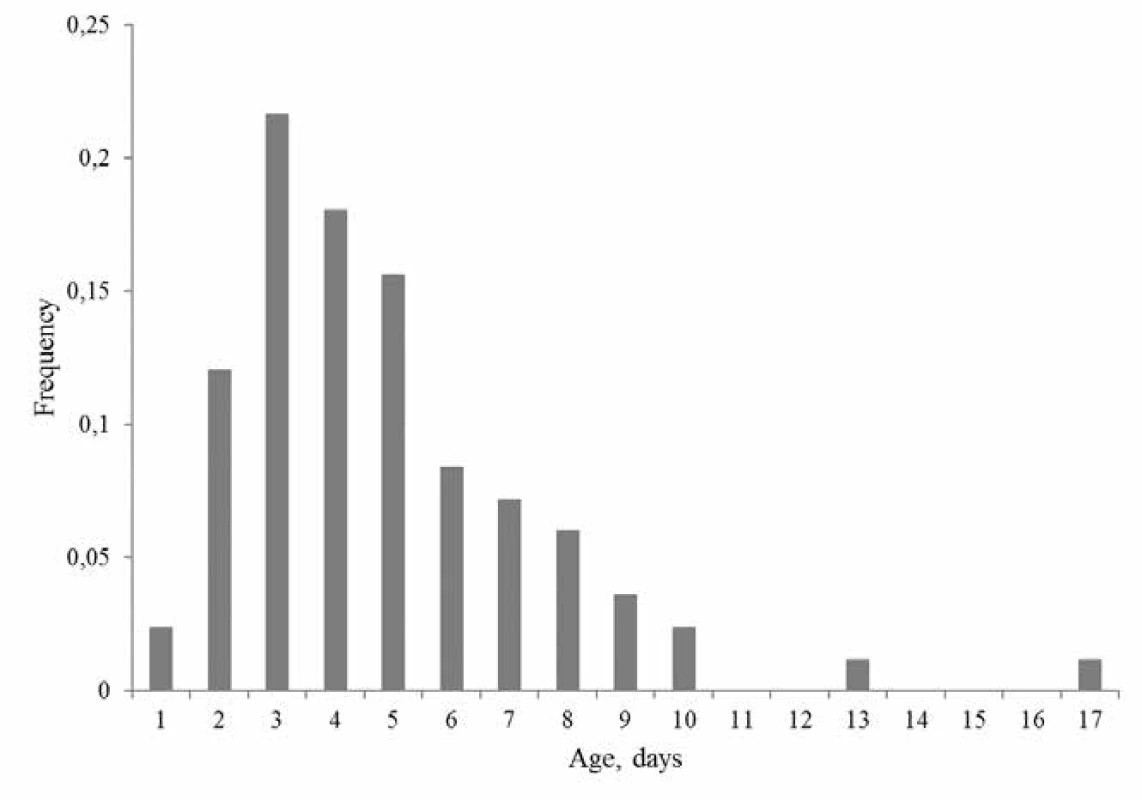
Retrospective data were statistically analyzed for the estimation of α2b-interferon usage and RVI findings. Analysis of patient’s medical records showed that all hospitalized patients were examined for the presence of rotavirus antigens in the clinical material (feces) by the indirect hemagglutination reaction method.
All 85 patients received basic pathogenetic pharmacotherapy with inclusion of enteral nutrition for every 6–8 hours, depending on the clinical condition. Infants with grade II of dehydration were treated with infusion pharmacotherapy for detoxification, rehydration, and partial parenteral nutrition. In case of bacterial complications, antibacterial pharmacotherapy was administered, taking into account the susceptibility of bacteria to antibiotics: gentamicin, second-generation cephalosporins, polymyxin, and others. If necessary, additional symptomatic pharmacotherapy was administered.
Across the retrospective data, 60 patients (70.6%) were found rotavirus positive (RV-positive). Among them, 31 RV-positive patients received α2b-interferon supplementation, administered rectally in the form of suppositories (after a cleansing enema) with a daily dosage of 50–100 thousand IU per kg of body weight, the course of treatment lasted 3–5 days. No complications of α2b-interferon use were observed (Table 1).
1. Statistical representation of retrospective data 
The further cost minimization analysis was conducted with the developed software tool »Pharmacoeconomic assessment of pharmacotherapy of viral infections«. It showed that the severity of the leading symptoms was significantly reduced with α2b-interferon supplementation regardless of the presence or absence of rotavirus. Graphically, it was characterized by corresponding hospitalization days (HD) curves with 95% confidence intervals (Fig. 2).
2. Hospitalization days probability (α2b-interferon supplementation; newborn patients) 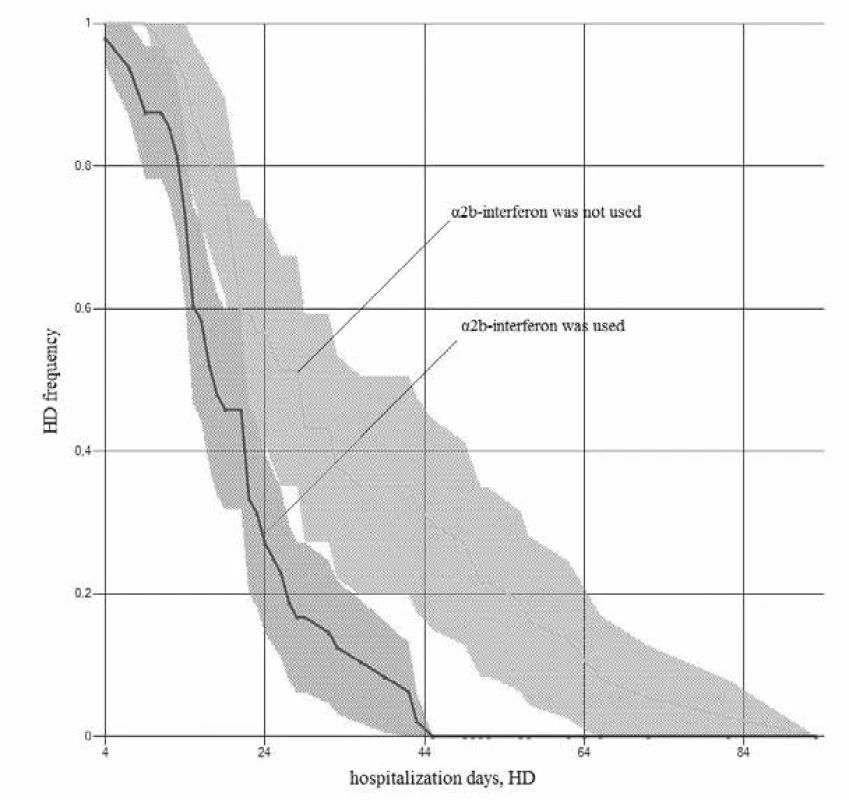
The detailed analysis noted that the usage of complex pharmacotherapy with α2b-interferon supplementation was characterized by faster reverse development of clinical manifestations of the disease in RVI-positive patients corresponding to appropriate HD curves with 95% confidence intervals (Fig. 3).
3. Hospitalization days probability (α2b-interferon supplementation; RVI-positive newborn patients) 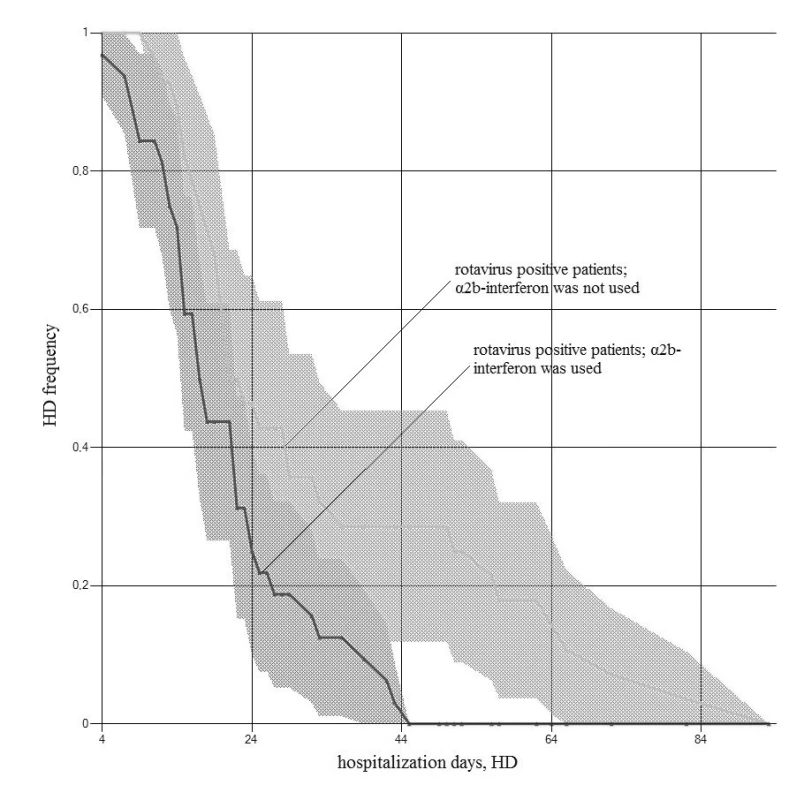
The final outcome of both interventions was the same regardless of intention used, the difference is purely in the time spent in hospital. So our goal was to study cost minimization effect of α2b-interferon supplementation in newborns with or without rotavirus infection. Every clinical data set studied was divided into four smaller data sets according to rotavirus infection presence (RV-positive/RV-negative) and α2b-interferon supplementation (Yes/No). Thus, we were able to divide every clinical dataset into four smaller ones and to estimate hospitalization duration distribution (Fig. 4).
4. Distribution of hospitalization duration for each alternative 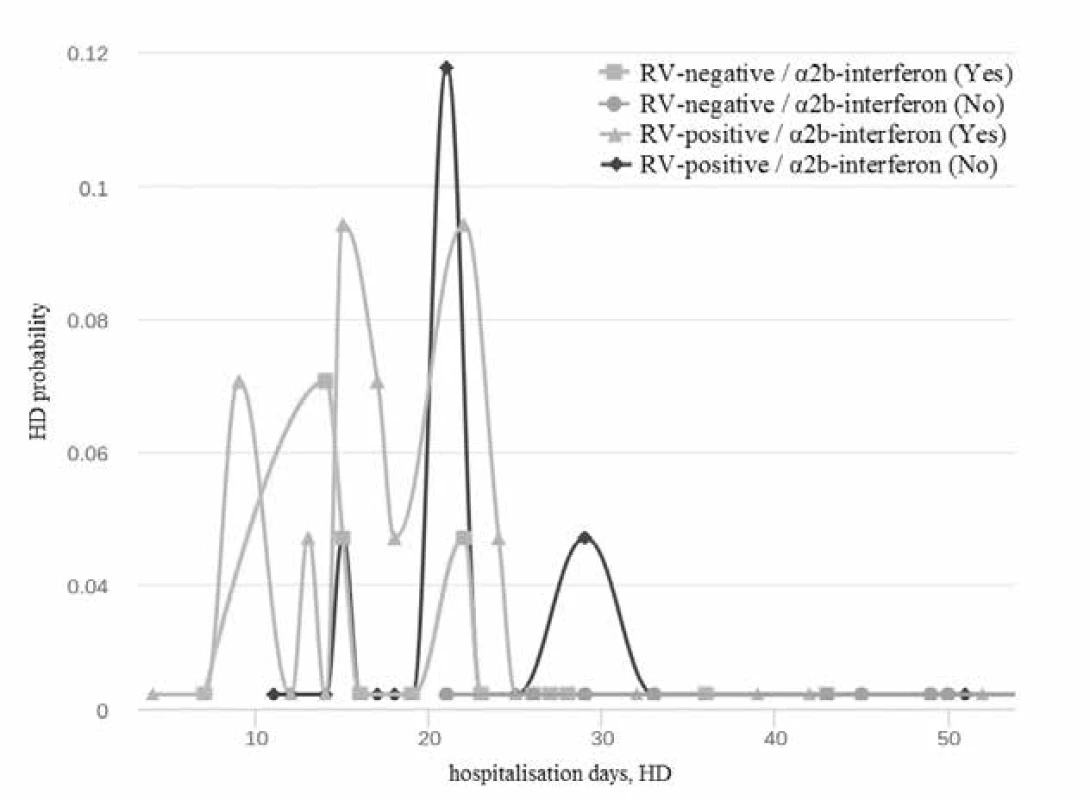
The perspective of the proposed cost minimization analysis referred to the economic vantage point of cost-of-illness. This affected all the types of costs (resource expenditures) and their minimization due to proposed pharmacotherapy. Analysis defined the currency reference that represented the resource expenditure associated with given costs but the costs were expressed as relative to each other, which allowed unifying the proposed methodology. The unified methodology could be focused on the institutional and patient perspective and treatment costs would be relevant to resource expenditures involved in the analyzed pharmacotherapy.
In the absence of information on the presence of a viral agent, the question arises of the choice of pharmacotherapy for an infectious disease. The algorithm of such a choice depends on possible outcomes: total cost in the absence of a viral infection of interest (Cn), and (Cv) – if present, when choosing the appropriate technology of pharmacotherapy.
To facilitate the adoption of pharmacotherapeutic solutions, the concept of the maximum probability of the presence of a viral infection is launched. The decision to choose the scheme of pharmacotherapy is taken following the maximum probability of the presence of viral infection31).
Expected costs (ECA(p)) when choosing a technology of pharmacotherapy of acute diarrhea without the use of α2b-interferon (pharmacotherapy A) are determined based on the constructed decision tree (Fig. 3).
where D – duration of hospital stay, presence (n) or absence (v) of the pathogen, ͞C – average costs per one day of baseline pharmacotherapy.
Expected costs (ECB(p)) in the choice of alternative pharmacotherapy with the inclusion of α2b-interferon (pharmacotherapy B)) can be determined from the lower branch of the decision tree as a weighted loss for two cases (rotavirus infection is absent or present), considering the relevant probability of their occurrence (Fig. 5):
5. Decision tree of α2b-interferon supplementation in complex pharmacotherapy of newborn and expected costs 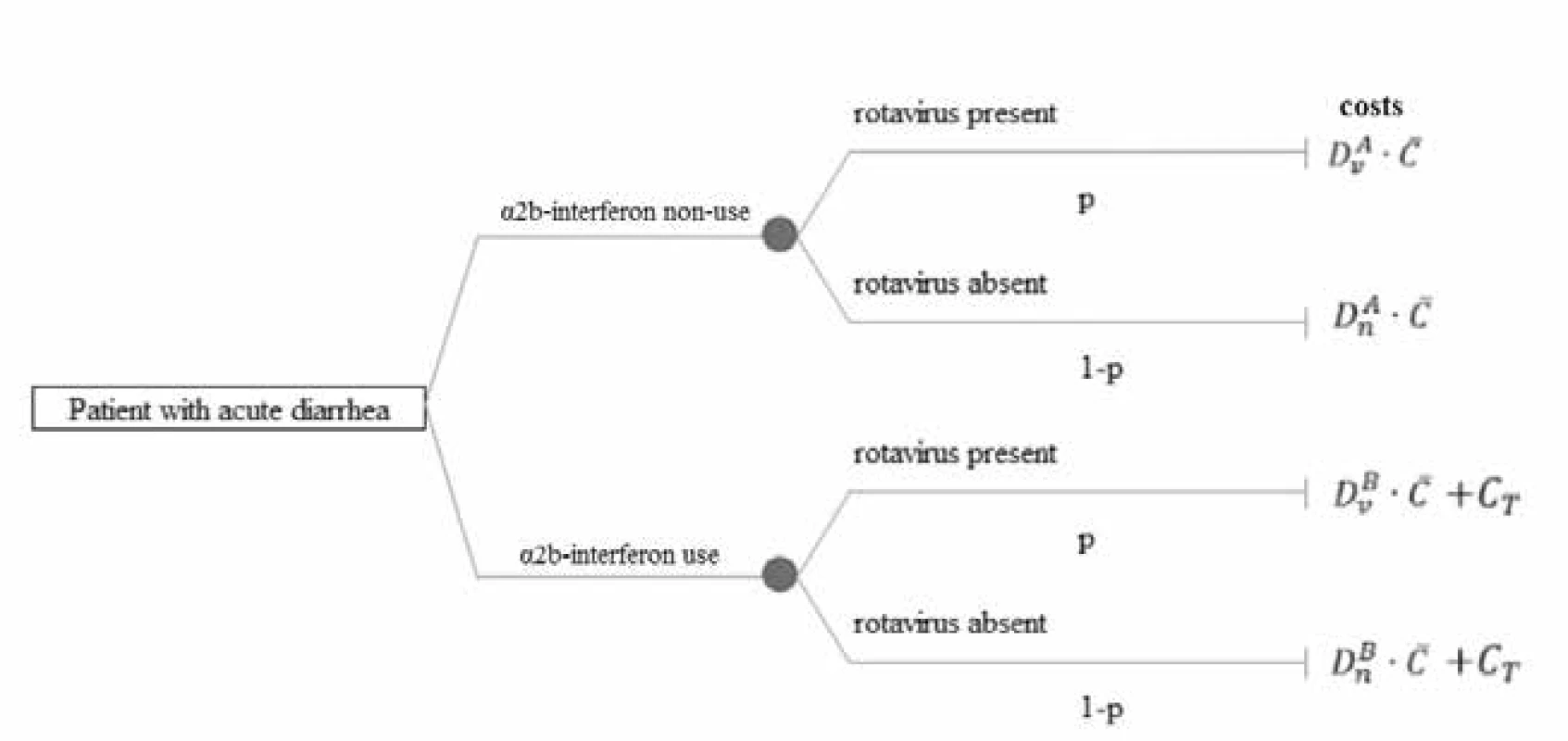
where D – duration of hospital stay, presence (n) or absence (v) of the pathogen, ͞C – average costs of one day of baseline pharmacotherapy, CT – costs for additional pharmacotherapy.
The technology of pharmacotherapy B is dominant in relation to pharmacotherapy A if the relevant condition is fulfilled:
The solution of equation [3] in relation to gives a cost saving criterion for decision-making in the pharmacotherapy of acute diarrhea under conditions of incomplete information:
In practice, one often faces significant variability in the length of hospitalization, which should also be considered when modeling using real retrospective clinical and laboratory data. Other assumptions underpinning the decision tree model included the etiological uncertainty of infectious disease within the decision to choose pharmacotherapy.
Results
Our proposal was to estimate its stochastic value according to [4] with the use of previously estimated distributions of hospitalization duration in each of four datasets by simulations in the developed software tool (Fig. 6).
6. Distribution of costs for additional treatment (CT )/baseline pharmacotherapy per day costs ( C) ratio 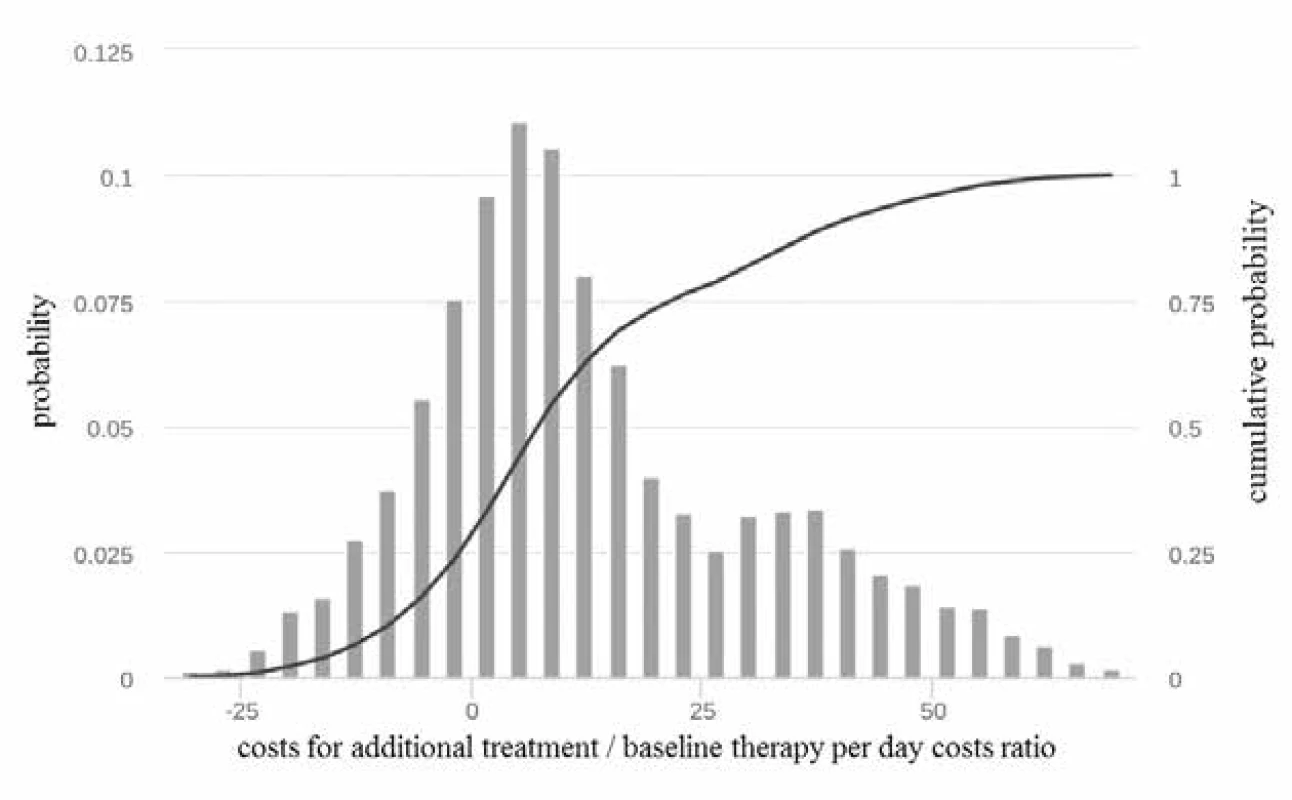
We found that with the probability of 0.25 (or 25%) this ratio would have negative value, meaning absolute domination of an absent α2b-interferon supplementation. Nevertheless, for 75% of simulated results, a critical ratio existed, reaching the mean value of 7.14. It means that on average, the decision of α2b-interferon supplementation as additional treatment could be appropriate if costs for additional treatment (CT) would be less than 714% of baseline pharmacotherapy per day costs ͞C.
The analysis of 1 day of base pharmacotherapy of acute gastroenteritis for children aged 1 month at the level of 577.08 UAH (2017) and the preparation of recombinant α2b-interferon 500000 IU, which is offered by the Ukrainian manufacturer with a price of 193.2–209.79 UAH (2020) showed that α2b-interferon supplementation will be cost-saving under a wide range of price even with significant increases in prices and inflation in the future32, 33).
Conclusions
The retrospective cost-saving analysis showed that the rectal application of recombinant α2b-interferon of RVI in newborns could increase the clinical effectiveness of the complex pharmacotherapy; namely, it could positively affect clinical manifestations of the disease through more rapid elimination of clinical symptoms. The results of the study prove that information technology based on cost minimization analysis could be an effective tool for clinical and pharmaceutical management of patients in a hospital and a reliable source for assessing the recovery rate, necessary to support decision-making in choice of optimal pharmacotherapy.
In our study, we found that α2b-interferon supplementation in the management of children with acute gastroenteritis resulted in faster reverse development of clinical manifestations of the disease. The wide uncertainty of results, determined in hospitalization days, could be explained by the fact that the dataset studied included patients with various clinical complications. Nevertheless, it was shown that the decision in favor of α2b-interferon supplementation as additional treatment could be cost-saving under 7.4 times lower price of α2b-interferon from public health care system perspective.
Definitely, our research has some limitations. In our study, we only estimated α2b-interferon supplementation in combination treatment of acute diarrhea. Nevertheless, it can also be performed easily on any combination of treatment effectiveness. However, from the other side, this requires a substantial amount of analytical work that falls beyond the scope of this paper.
Acknowledgments
The study was conducted as a part of research work: »Optimization of diagnosis, prevention and treatment strategies of actual viral infections on the basis of clinical and laboratory, pharmacoeconomic and pharmacoepidemiological studies« (State registration number in Ukraine 0115U002161).
Conflict of interest: none.
PharmDr. Serhii O. Soloviov (∗)
Virology Department
Shupyk National Medical Academy of Postgraduate Education
Dorogozhitska str. 9, 04112 Kyiv, Ukraine
e-mail: solovyov.nmape@gmail.com
Applied Mathematics Department
National Technical University of Ukraine “Igor Sikorsky Kyiv Polytechnic Institute”, Kyiv, Ukraine
T. A. Aleksandrina • O. V. Kovaliuk • I. V. Dziublyk
Virology Department
Shupyk National Medical Academy of Postgraduate Education, Kyiv, Ukraine
S. H. Ubohov
Quality Control and Standardization of Medicines Department
Shupyk National Medical Academy of Postgraduate Education, Kyiv, Ukraine
V. V. Trokhymchuk • H. V. Zahoriy
Organizations and Economics of Pharmacy Department
Shupyk National Medical Academy of Postgraduate Education, Kyiv, Ukraine
Sources
1. Enserink M. What’s Next for Disease Eradication? Science 2010; 330(6012), 1736–1739.
2. Michael J. Selgelid. Smallpox Revisited? Am. J. Bioeth. 2003; 3(1), 5–11.
3. Almond D. Is the 1918 influenza pandemic over? Long-term effects of in utero influenza exposure in the post-1940 US population. J. Political Econ. 2006; 114, 672.
4. Kelly E. The Scourge of Asian Flu In utero Exposure to Pandemic Influenza and the Development of a Cohort of British Children. J. Hum. Resour. 2011; 46, 669–694.
5. Dziublyk I., Voronenko S., Mironenko A., Vynograd N. Diagnosis, pharmacotherapy and prevention of influenza, 1st ed. Kyiv: Medknyha 2011.
6. Dziublyk I.V. Influenza and its prevention: teach. manual, 1st ed. Kyiv: Shupyk KMAPE 2005.
7. Leleka M. V. Use of modeling in the study of economic burden of influenza in the elderly population in Central and Eastern European countries. Farm. Zh. 2017; 3–4, 34–43. https://doi.org/10.32352/0367-3057.3-4.17.04
8. Adda J. Economic Activity and the Spread of Viral Diseases: Evidence from High Frequency Data QJE 2016; 131, 2891–2941.
9. Pokrovsky V. I. Bricco N. I. Infectious Diseases in the Age of Globalization. Bull. RAMS 2010; 11, 6–11.
10. Kawai K., O’Brien M. A., Goveia M. G., et al. Burden of rotavirus gastroenteritis and distribution of rotavirus strains in Asia: a systematic review. Vaccine 2012; 30(7), 1244–1254. doi:10.1016/j.vaccine.2011.12.092
11. Tate J. E., Burton A. H., Boschi-Pinto C., et al. Estimate of worldwide rotavirus-associated mortality in children younger than 5 years old before the introduction of universal rotavirus vaccination programmes: a systematic review and meta-analysis. Lancet Infect. Dis. 2012; 12(2), 136–141. doi:10.1016/S1473-3099(11)70253-5
12. Sergeevnin V. I. Acute intestinal infections. Manifestations of the epidemic process. Physician 2013; 9, 18–20.
13. Shilov G. Yu. Analysis of the incidence of acute intestinal infections in the Russian Federation, the United States and EU countries. Food Ind. 2013; 10, 50–54.
14. Lavreonova E. S., Podkolzin A. T., Konovalova T. A., et al. Estimation of the role of conditionally pathogenic flora in the development of acute diarrheal diseases. Infect. Dis. 2012; 10, 53–55.
15. Lobzin Yu. V. Clinic, epidemiology and prophylaxis of rotavirus infection: methodological recommendations. St. Petersburg: SRICI 2013.
16. Dziublik I., Nadraga O., Obertynska O., Voronenko S., et al. Viral diseases of guts in children. Collect. Sci. Works Shupyk NMAHE Staff 2008; 17(2), 620–632.
17. Abaturov A. E., Stepanova Yu. Yu., Krivush O. L., Gerasimenko O. M. Approaches to the treatment of rotavirus infection in children. Mod. Pediatr. 2013; 1(49), 1–4.
18. Shalamay M. O., Storozhuk I. V. Features of rotavirus infection in young children. Biomed. Biosoc. Anthropol. 2014; 23, 32–135.
19. Gorelov A. V., Usenko D. V. Rotavirus infection in children. Issues Mod. Pediatr. 2008; 7(6), 78–85.
20. Dziublyk I. V., Obertinskaya O. V., Kostenko I. G., et al. Rotavirus infection in children of Ukraine. Prophyl. Med. 2009; 2, 34–37.
21. Soloviov S. O., Mohort H. A., Dziublyk I. V. Determination of age-dependent parameters of the epidemic process of rotavirus infection in Ukraine. Med. Sci. Ukr. 2016; 12(1–2), 72–77.
22. Soloviov S. O., Mokhort H. A., Trokhimenko O. P., Zahoriy H. V., Trokhymchuk V. V., Kolesnikova I. P., Dziublyk I. V. Pharmacoeconomic and epidemiological bases of optimal rotavirus vaccine supply for Ukrainian population. Wiad. Lek. 2019; 7, 1274–1280.
23. Dziublyk I. Guide for viral infections chemotherapy: Textbook for Physicians, 1st ed. Kyiv: Shupyk KMAPE 2004.
24. Shunko Ye. E., Dziublyk I. V, Tunda I. P., Barbova G. I., Kovalyuk O. V. Rotavirus infection in the maternity hospital according to virologic examinations. Ukr. Med. J. 2000; 5(19), 72–75.
25. Dziublyk I. V. Interferons: nature, mechanisms of action and clinical use of interferon drugs. Child Health 2016; 5, 79–84.
26. Usacheva O. V., Pakholchuk T. M., Silina E. A., Matveeva T. B., Shulga O. V., Pechugina V. V., Berestova I. V., Stibler A. V., Turlun V. A. Features of the course of rotavirus infection in infants with cytomegaly and approaches to pathogenetic therapy. Mod. Pediatr. 2013; 1, 134–138.
27. Khalilov Z. S., Yodgorova N. T. Modern methods of diagnosis and treatment of rotavirus intestinal diseases. Re-health J. 2019; 3, 69–90.
28. Malyshev N. A., Safonova O. A. Rotavirus infection in children: features of the immune response and experience with the use of a new release-active drug. Med. Advice 2016; 7, 70–76.
29. Feklisova L. V., Meskina E. R., Galkina L. A., Kazakova S. P., Savitskaya N. A., Tselipanova E. E. New approaches to the treatment of viral and bacterial infections in children. Clin. Med. Alm. 2005; 8–1, 338–346.
30. Tikhomirova O. V., Sergeeva N. V., Sirotkin A. K., Aksenov O. A., Kvetnaya A. S. Viral diarrhea in children: clinical features and treatment tactics. Infant Infect. 2003; 3, 7–11.
31. Soloviov S. O., Dziublyk I. V., Zaliska O. M., Sakhno G. O. Analytical substantiation of the inclusion of an antiviral drug in the treatment of patients with suspected acute viral diseases. Ann. Mechnikov Inst. 2016; 4, 18–26.
32. Nemchenko A. S., Balynska M. V. Results of pharmacoeconomic research on the treatment of viral origin enterities in children (on the example of rehydration therapy). Pharm. Chasopys. 2017; 1, 68–73. https://doi.org/10.11603/2312-0967.2017.1.7532
33. Laferobion suppositories for 500,000 IU No. 10 (5x2): price in Kyiv https://tabletki.ua/%D0%9B%D0%B0%D1%84%D0%B5%D1%80%D0%BE%D0%B1%D0%B8%D0%BE%D0%BD/22248/pharmacy/?s=price (02. 04. 2020).
Labels
Pharmacy Clinical pharmacology
Article was published inCzech and Slovak Pharmacy
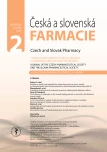
2020 Issue 2-
All articles in this issue
- Advances in the use of instrumental measurement of colour in the development, production and quality control of drugs, medicinal preparations and pharmaceutical auxiliary substances III
- Nové knihy
- Rosuvastatin-induced rhabdomyolysis due to medication errors
- Evaluation of adherence to treatment in patients suffering from diabetes mellitus
- The influence of «Saprogel» in the wound healing process on rats with a full-thickness wound model
- A cost minimization analysis of α2b-interferon supplementation in complex pharmacotherapy of rotavirus infection in newborns
- Formulation and technology development of vaginal pessaries with probiotic activity
- Czech and Slovak Pharmacy
- Journal archive
- Current issue
- Online only
- About the journal
Most read in this issue- Evaluation of adherence to treatment in patients suffering from diabetes mellitus
- Rosuvastatin-induced rhabdomyolysis due to medication errors
- Formulation and technology development of vaginal pessaries with probiotic activity
- Advances in the use of instrumental measurement of colour in the development, production and quality control of drugs, medicinal preparations and pharmaceutical auxiliary substances III
Login#ADS_BOTTOM_SCRIPTS#Forgotten passwordEnter the email address that you registered with. We will send you instructions on how to set a new password.
- Career

